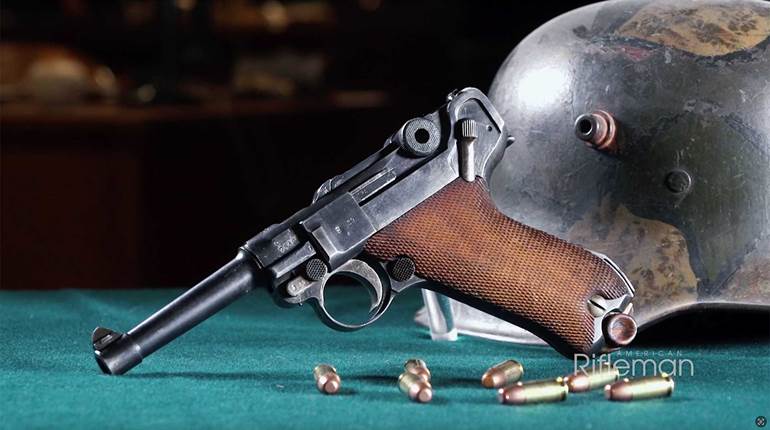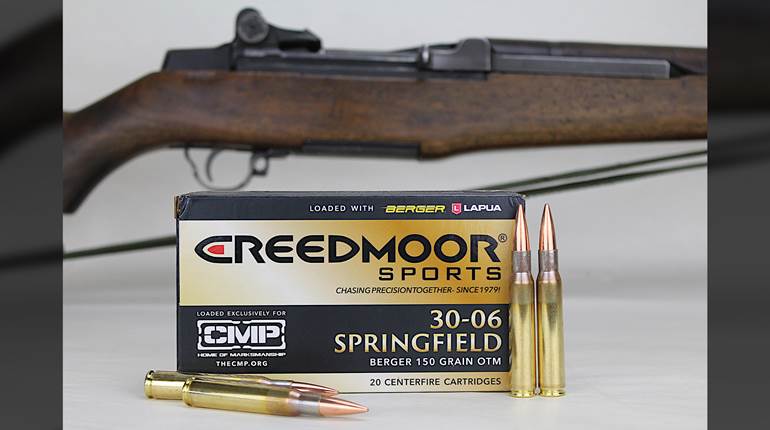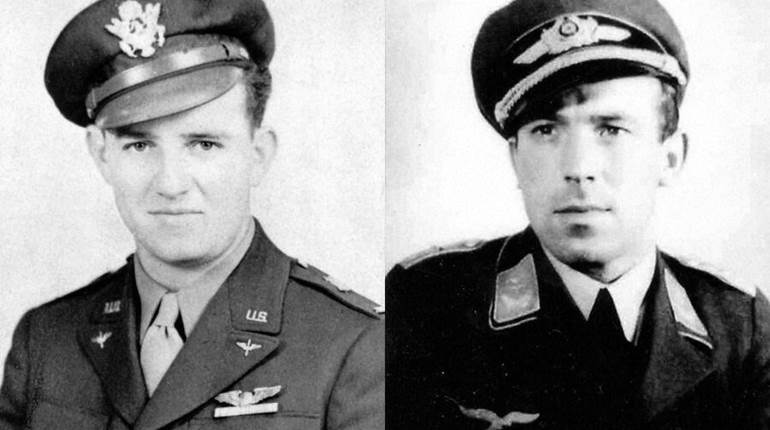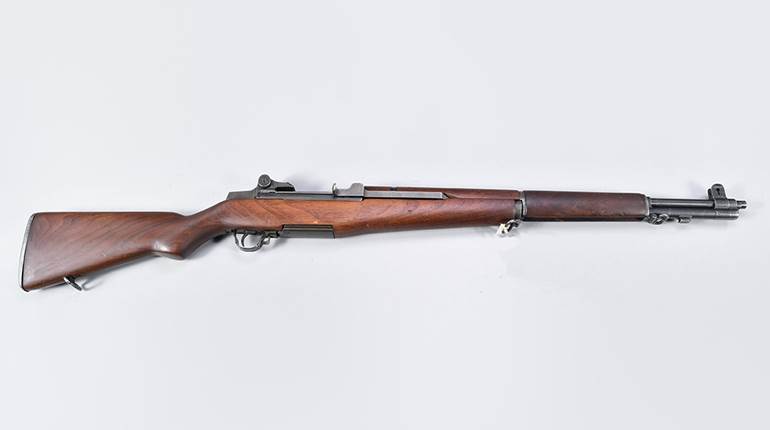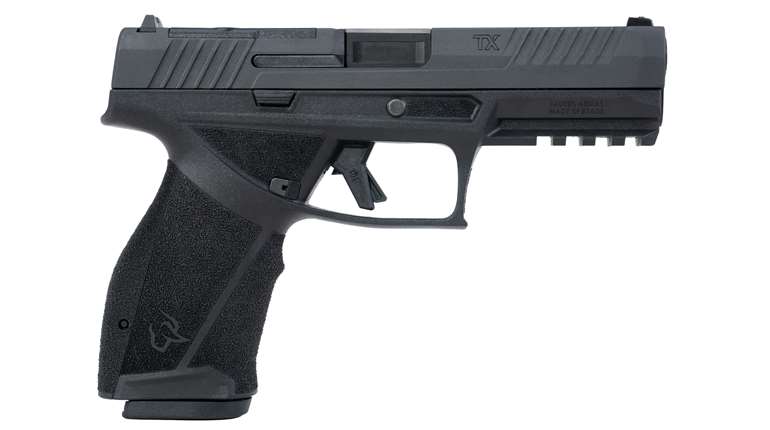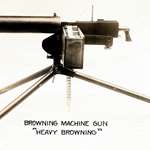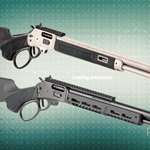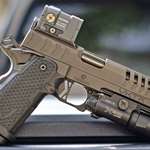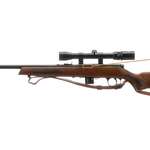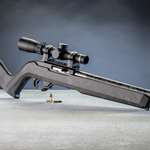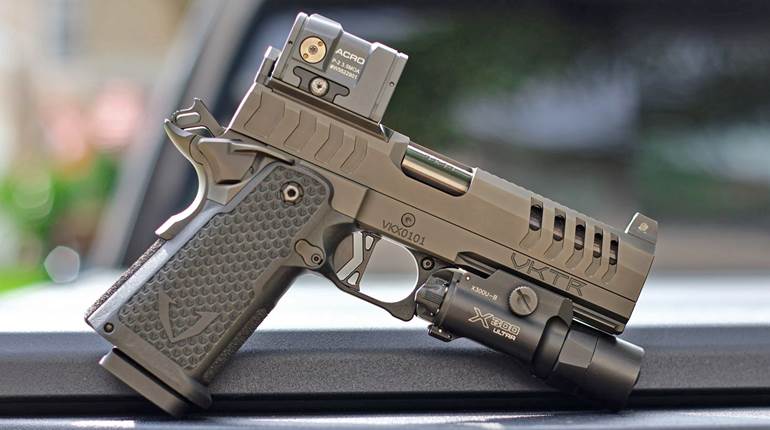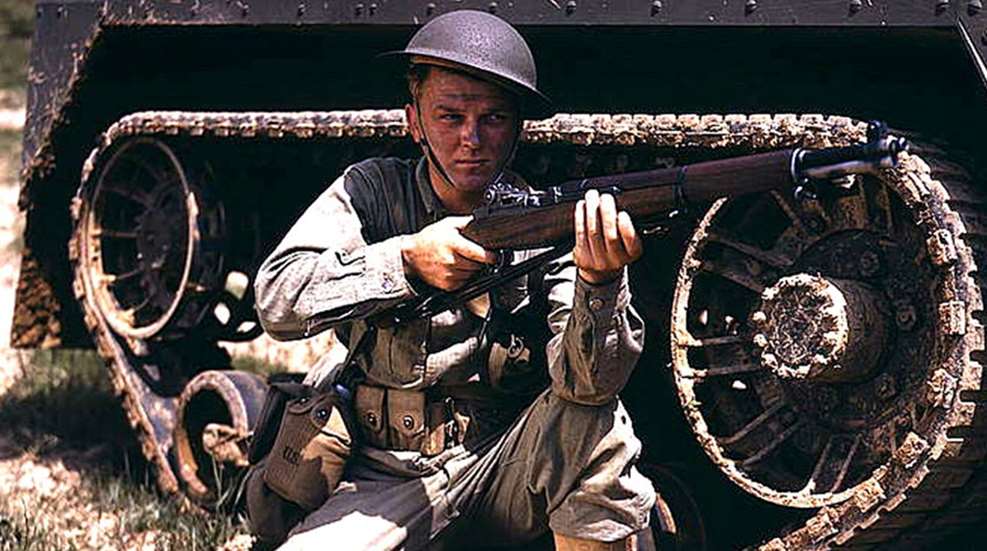
An early 1942 photo shows a U.S. Army soldier (above) armed with a Garand posed by an M2 halftrack.
The enduring images of the M1 Garand are photos of victory, of a war-winning rifle carried into combat by battle-hardened G.I. marksmen. The Garand was one of the essential elements of triumph over the Axis forces in World War II—a rifle that helped save the world for free men. What has faded from our collective memory is the fact that the M1 rifle was in action from the very start of the land war in the Pacific. The Garand’s first shots fired in anger bloodied the Japanese during their invasion of the Philippines, which began on the morning of Dec. 8, 1941. This first battle was a brutal test for American troops, who fought with little hope of relief, and ultimately ended in defeat, surrender, the horrors of the Bataan Death March and the Japanese occupation of the Philippine Islands.
 The M1 rifle was sent in some numbers to the Philippines prior to the Japanese invasion, and equipped many riflemen in the U.S. Army’s Philippine Division, as well as some of the elite Philippine Scouts. A number of these rifles were of the “gas trap” variety, and some of the early gas-port rifles were used as well. The remainder of the American and Filipino troops were armed with M1903 Springfield and M1917 Enfield rifles also chambered in .30-’06 Sprg.
The M1 rifle was sent in some numbers to the Philippines prior to the Japanese invasion, and equipped many riflemen in the U.S. Army’s Philippine Division, as well as some of the elite Philippine Scouts. A number of these rifles were of the “gas trap” variety, and some of the early gas-port rifles were used as well. The remainder of the American and Filipino troops were armed with M1903 Springfield and M1917 Enfield rifles also chambered in .30-’06 Sprg.
The M1 rifle represented a significant change in small arms design, and that did not always sit well with the more experienced men in some units. According to Donald J. Young in The Battle of Bataan: A Complete History, “[S]ome of the veteran Philippine Scouts, who had been weaned on the 1903 Springfield, never felt quite comfortable with the new weapon in combat. Consequently, word was soon passed that it was pretty easy to find a Scout who was willing to trade his M1 for an old-reliable ’03. With wind of this story, two young naval officers from the Mariveles section base, after getting a first-time look at the M1, decided they’d hike up to the 57th Infantry bivouac area two or three miles up the West Road in hopes of bartering away a couple of Navy-issue Springfield ’03s for two of the new rifles.”
“Both the Americans and Scouts carried the new semi-automatic M1 Garand rifle. Its eight-round clip and rapid fire—20 to 30 aimed shots a minute—surprised the first Japanese to come up against it,” wrote John W. Whitman in Bataan: Our Last Ditch. “The sights were designed to give good visibility at night, and it proved to be one of the most reliable and rugged rifles in military history. The M1’s replacement of the beloved M1903 Springfield did not sit well with all soldiers, especially with the older men who were proud of their careful trigger squeeze and marksmanship. The M1 seemed to encourage volume of fire over accuracy, and when the war started, some men went to the extreme of swapping their M1s for, or buying, ’03s.”

As the campaign in the Philippines ended in defeat, there is very little official documentation about the first combat use of the M1 rifle. Nonetheless, American Rifleman Field Editor Bruce N. Canfield has collected some evidence of the M1 rifle’s service in this ill-fated campaign.
The Feb. 23, 1942, edition of The Washington Post carried a story titled “Bataan Proves Garand Worth.” A New York Times story on the very same day reported “Garand Rifle Praised by Gen. MacArthur.” During that week, Time magazine printed an article titled “The Garand in Action” that described the M1’s early combat performance as validating MacArthur’s decision to retain the .30-’06 Sprg. cartridge for use in the Garand rifle. Neither American nor Filipino troops had to be provided with different ammunition as .30-’06 Sprg. cartridges worked with the M1917 Enfield, the M1903 Springfield, the M1917 Browning machine guns and the remaining .30-cal. Lewis guns.
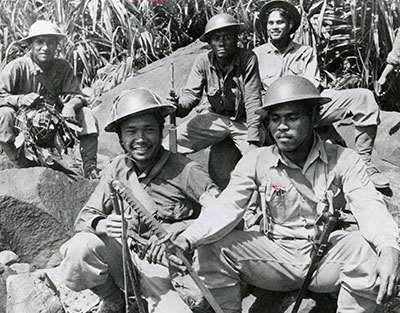
On Feb. 24, 1942, Maj. Gen. Charles Wesson sent a telegram about the M1 rifle’s combat performance to the workers at the Winchester factory: “Here’s a message from General MacArthur praising the superiority of the Garand rifle in combat. The General says that in the hands of our brave soldiers, the Garand operated with deadly precision even in the dust and dirt of foxhole fighting, and in many cases was in constant action for a week without cleaning or lubrication. This tribute from General MacArthur should be an inspiration for you men and women of Winchester who are now producing this remarkable weapon.”
The following remarks came from Earl McFarland, commanding officer at Springfield Armory, addressing the workers at the armory: “In the heat of a losing battle in Bataan, General Douglas MacArthur took time to cable the War Department in Washington that our M1 rifles were performing with excellence and distinction. Captured Japanese soldiers inquired how America was able to arm every soldier with a machine gun. These weren’t machine guns. They were M1 rifles!”
The new semi-automatic rifle drew praise from friend and foe alike. The commander of the 3rd Battalion, 57th Regiment, Philippine Scouts, Lt. Col. Philip Fry, described the effect of the M1 rifles as reported by Bill Sloan in Undefeated: America’s Heroic Fight for Bataan and Corregidor: “The firepower of a battalion armed with modern weapons is something. The Garand rifle is beyond my descriptive powers.”
The Japanese troops that led the invasion were well-experienced from their years of combat in China. But they had never faced such an incredible volume of small arms fire directed at them from disciplined and motivated marksmen. This increased rate of fire from the M1 rifles helped exact an enormous toll on Japanese infantry. From the Battle of Quinauan Point came this description in Bataan: Our Last Ditch “… the Scout riflemen built up a tremendous volume of fire with M1 rifles, machine guns and even pistols, until it was impossible to hear anything but the roar of the guns.”
Anecdotal evidence suggests that there was a shortage of M1 rifle en bloc clips available to the troops in the Philippines and, as this was the first combat action of the M1 rifle, unfortunate situations of that nature were likely. How this shortage of M1 clips impacted the rifle’s performance is not fully known, but anyone who has ever assembled eight .30-’06 rounds together into an M1’s en bloc clip knows that this is not the type of thing you want to do in hurry, in the dirt and under fire. Until I began to research this article, I never realized what an incredible luxury it is to have my M1 rifle clips “pre-packed” before I head out to the range.
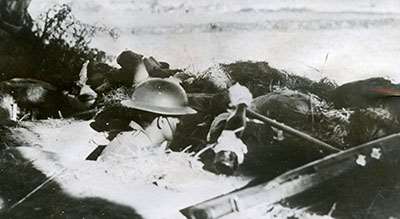
An example of the clip scarcity was given in Corregidor: The American Alamo in World War II by Eric Morris: “[W]ith the 11th Infantry on Bataan … each rifleman carried 160 rounds of M1 ammunition, and the machine gunners carried 1,000. Although rifle ammunition was in adequate supply, there was a shortage of M1 clips, which reduced the Scouts to stripping the .30 caliber rounds from five-round Springfield rifle clips and putting them into the eight-round M1 clips.”
This scenario was repeated many times over until the bitter end of the battle. Clearly, the logistics of small arms supply were stretched to their limits. Again, according to Whitman,“[O]n the day before the surrender, a single half-ton weapons carrier arrived at 0230 hours, carrying five cases of .30 caliber rifle ammunition in five-round clips unsuitable for M1 rifles, each round had to be removed from the Springfield clips and loaded into the eight-round M1 clips.”
When the brave defenders of Bataan surrendered on April 9, 1942, it is reported that survivors destroyed their remaining Garand rifles to prevent them from falling into Japanese hands. Undoubtedly the Japanese acquired some examples of the M1 rifle in the Philippines during 1942, but even though the Japanese created a few reverse-engineered prototype copies of the M1, they failed to deploy their own semi-automatic rifle by the war’s end.
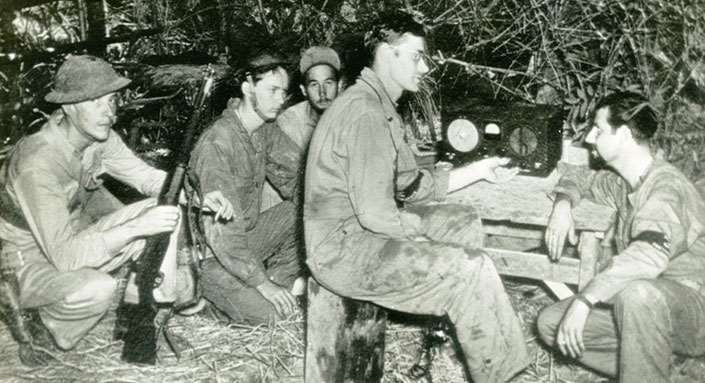
The “Voice of Freedom” on Bataan, April 9, 1942, summed up the American surrender. “Bataan has fallen. The Philippine-American troops on this war-ravaged and bloodstained peninsula have laid down their arms. With heads bloody but unbowed, they have yielded to the superior force and numbers of the enemy. The world will long remember the epic struggle that Filipino and American soldiers put up in the jungle fastness and along the rugged coast of Bataan. They have stood up uncomplaining under the constant and grueling fire of the enemy for more than three months. Besieged on land and blockaded by sea, cut off from all sources of help in the Philippines and in America, the intrepid fighters have done all that human endurance could bear.”
As for the M1 rifle, it earned its place in U.S. military firearm history as the “greatest battle implement ever devised” with its performance throughout World War II. The Garand was there at the beginning, when the Japanese attacked in December 1941. It was also there at the end, returning along with Gen. Douglas MacArthur to the Philippines in October 1944, liberating the islands and fulfilling the blood oath sworn on Bataan.












